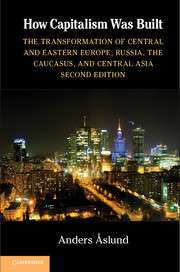 How Capitalism Was Built
How Capitalism Was Built From Slump to Recovery and Boom
Published online by Cambridge University Press: 05 December 2012
A fundamental but poorly understood issue of postcommunist economic transformation is what happened to output. There is no agreement on the fundamental facts, and the statistical uncertainties are too great for any consensus to emerge any time soon. Throughout the region, transition started with huge recorded falls in output. Some argued that a unique devastation was taking place; others saw a combination of measurement problems and “creative destruction” in Joseph Schumpeter’s (1943/1976) sense.
The universal output slump after communism has been greatly exaggerated. Output did fall, but not nearly as much as officially recorded. A substantial part of the big recorded decline, probably about half, was not real but can be explained with factors such as mismeasurement, an expansion of the unregistered economy, and the elimination of value detraction. In addition, several countries lost substantial subsidies and many implicit trade subsidies. The main economic concern was the long delay in economic recovery in many countries rather than the initial slump.
The initial development of output was closely correlated with reform policies. The output fall lasted much longer and was steeper in the former Soviet Union than in Central and Eastern Europe. The two extremes were the neighbors Poland, which returned to growth in its third year of transition, and Ukraine, which experienced ten years of economic decline. Radical reformers soon returned to growth, whereas partial and nonreformers experienced a long period of contraction. The covariation between many possible causes makes it impossible to distinguish the decisive reason, but hyperinflation and the general collapse of the state are strong candidates.
To save this book to your Kindle, first ensure no-reply@cambridge.org is added to your Approved Personal Document E-mail List under your Personal Document Settings on the Manage Your Content and Devices page of your Amazon account. Then enter the ‘name’ part of your Kindle email address below. Find out more about saving to your Kindle.
Note you can select to save to either the @free.kindle.com or @kindle.com variations. ‘@free.kindle.com’ emails are free but can only be saved to your device when it is connected to wi-fi. ‘@kindle.com’ emails can be delivered even when you are not connected to wi-fi, but note that service fees apply.
Find out more about the Kindle Personal Document Service.
To save content items to your account, please confirm that you agree to abide by our usage policies. If this is the first time you use this feature, you will be asked to authorise Cambridge Core to connect with your account. Find out more about saving content to Dropbox.
To save content items to your account, please confirm that you agree to abide by our usage policies. If this is the first time you use this feature, you will be asked to authorise Cambridge Core to connect with your account. Find out more about saving content to Google Drive.